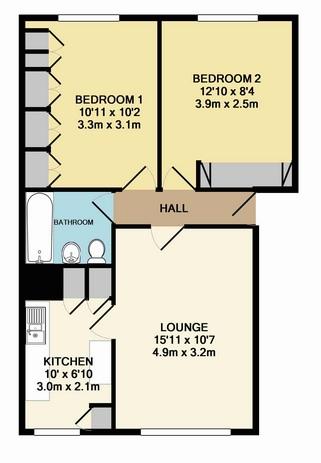Please help!
I live in a 1960s flat with a bathroom with no window and an old extract fan. The flat upstairs has a bathroom in the same place, and we are separated by a concrete floor.
I am in the process of decorating my bathroom ceiling. It was covered in anaglypta lining paper which I have removed. As I removed the paper I realised that there was a layer of PVA glue sealer on the plaster. (Now, this sealer could have been the backing from the old lining paper, or it could have been purposely applied to the plaster). As I removed some of the paper, some of the sealer came off with it, so I thought it best to remove all the PVA glue from the ceiling.
(Regardless, I have been told never to apply PVA glue to plaster, as it blisters up when you paint over it, so I thought it a good thing to remove it all).
The ceiling is now bare plaster.
My problem is this:
I have suddenly realised that half of the ceiling is bone dry, and the other half (when you touch it) is cold and damp. The plaster is a shade darker on the ceiling above the bath area and extends a little beyond. The damp patch is permanently the same. I only shower once a day, and so I would expect the ceiling to dry out (or the damp to creep back a bit) exactly 24hrs after my last shower
I do not believe there is a leak upstairs, as I don't think that the water can seep through concrete.
And I would not expect the leak to cover the ceiling wall to wall as it currently does.
I always shower with the bathroom door open to let steam out.
I have a really old extractor fan from the 1960's, but this doesn't seem very effective – but even so, I would have expected the ceiling to dry out a bit after 24hrs.
Basically – how can I dry my ceiling out?
I'd be grateful on any advice as so that I can paint it once it has dried out. (Good quality bathroom paint of course when the time comes).
Look forward to your replies!
I live in a 1960s flat with a bathroom with no window and an old extract fan. The flat upstairs has a bathroom in the same place, and we are separated by a concrete floor.
I am in the process of decorating my bathroom ceiling. It was covered in anaglypta lining paper which I have removed. As I removed the paper I realised that there was a layer of PVA glue sealer on the plaster. (Now, this sealer could have been the backing from the old lining paper, or it could have been purposely applied to the plaster). As I removed some of the paper, some of the sealer came off with it, so I thought it best to remove all the PVA glue from the ceiling.
(Regardless, I have been told never to apply PVA glue to plaster, as it blisters up when you paint over it, so I thought it a good thing to remove it all).
The ceiling is now bare plaster.
My problem is this:
I have suddenly realised that half of the ceiling is bone dry, and the other half (when you touch it) is cold and damp. The plaster is a shade darker on the ceiling above the bath area and extends a little beyond. The damp patch is permanently the same. I only shower once a day, and so I would expect the ceiling to dry out (or the damp to creep back a bit) exactly 24hrs after my last shower
I do not believe there is a leak upstairs, as I don't think that the water can seep through concrete.
And I would not expect the leak to cover the ceiling wall to wall as it currently does.
I always shower with the bathroom door open to let steam out.
I have a really old extractor fan from the 1960's, but this doesn't seem very effective – but even so, I would have expected the ceiling to dry out a bit after 24hrs.
Basically – how can I dry my ceiling out?
I'd be grateful on any advice as so that I can paint it once it has dried out. (Good quality bathroom paint of course when the time comes).
Look forward to your replies!



